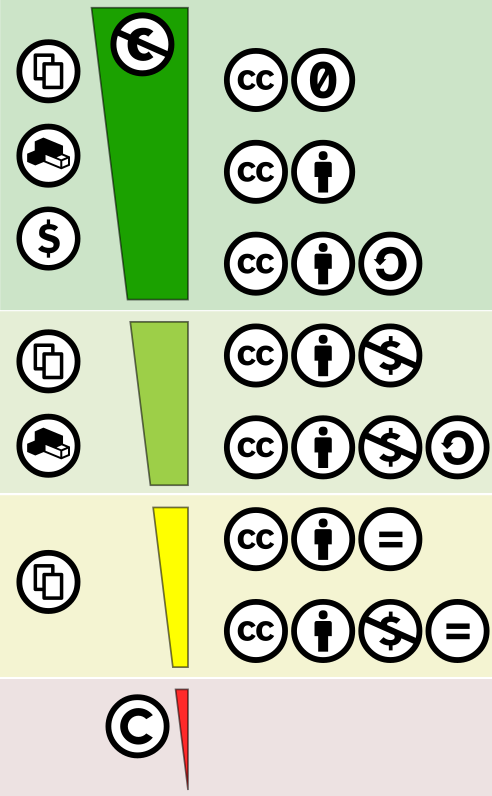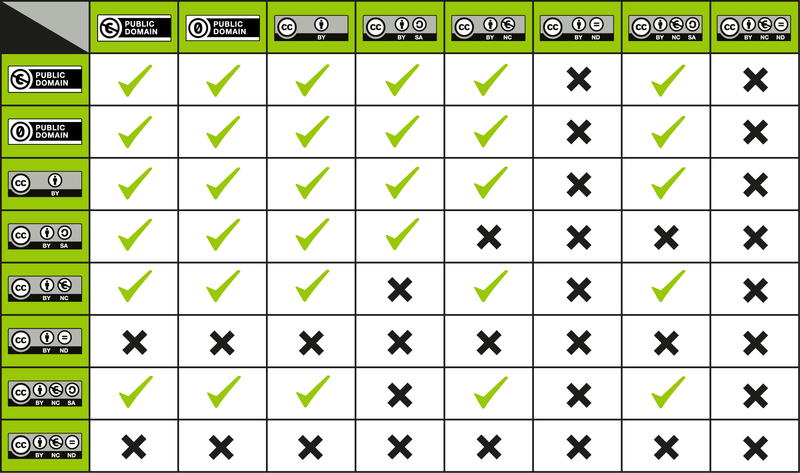Open Science for Arts, Design and Music/Guidelines/Creative Commons Licenses
Creative Commons Licenses
editCreative Commons (CC) Licenses are probably the most known and most widely used copyright non-exclusive licenses. CC Licenses promote the sharing and re-use of creativity and knowledge by replacing the default 'all right reserved' approach of copyright, with the 'some rights' reserved approach. In other words, they enable right holders (licensors) to release some of the rights that are granted by copyright law. CC licenses grant others (licensees) permission to use, share and modify licensors' creative works, and clearly define the conditions for such re-use.
CC licenses are free of charge and can be used for any type of copyrighted work (including research data, educational resources, scientific publications, music, pictures, databases, sound, video etc), except for softwares. They are irrevocable: licensors are not allowed to change towards a more restrictive license as this would break the whole system. However, licensors are always allowed to change the license to a less restrictive one (e.g. from CC BY-SA-NC to CC0), as this change does not create any troubles with previous usages of the work. CC Licenses are non-exclusive (creators and owners can enter various licensing arrangements for the same work at any time) and do not affect moral rights.
CC licenses vs. Copyright
editCC Licenses do not substitute copyright laws but simply offer right holders the possibility to organize and manage rights within the framework of existing copyright legislation. CC licenses are built within copyright law. A such they can be applied only to copyrightable works by the right holder. CC licenses cannot be applied to works that are included in the worldwide public domain. They do not limit or suppress any of the rights that are granted under the exceptions and limitations to copyright. Other types of intellectual property (e.g., patents and trademarks) are not covered by CC licenses. Creators retain the copyright and their right to be credited, while permitting reusers to copy and distribute their work. They work internationally and have they same lifespan as copyright.
CC licenses
editCC licenses provide a range of options for creators who want to share their works with the public rather than reserving all rights under copyright.
They consist of three layers design:
| Design layer | Definition |
| 'lawyer readable' legal code | these are the legal terms and conditions that can be enforced in court |
| 'human readable' common deeds | this is plain language summary of legal terms and conditions |
| 'machine readable' metadata | this layer is written into a format for use by search algorithm and other softwares. |
There are six CC licenses that are a combination of one or more of the following four elements:
The main decisions that a licensor must take when choosing one of the six CC licenses are:
- Do I want to allow commercial use?
- Do I want to allow derivative works? If so, do I want the adaptations to be shared under the same or compatible license?
Depending of the answers, the licensor can choose among six different license options, from least to most restrictive:
CC licenses and the Public Domain
editIn addition to the CC license suite, CC also has two public domain tools. Public domain tools and licenses are not equivalent.
Open vs Not-Open CC Licenses
editAccording to the Berlin Declaration on Open Access to Knowledge in the Sciences and Humanities, all users should have a free, irrevocable, worldwide right of access and permission to copy, use, distribute, (...), make and distribute derivative works in any digital medium, for any responsible purpose, subject to proper attribution of authorship. Therefore, only three CC licenses are completely in line with such definition of “open”: CC0, CC-BY and CC-BY-SA. The other four CC licenses - CC BY-ND, CC BY-NC, CC BY-NC-ND and CC BY-NC-SA - are not considered “open” for they are more restrictive than the "open" requirements.

Creative commons license spectrum by Shaddim is licenced under CC BY 4.0
License your work
editBefore choosing a CC license check that you control copyright in the work to which you wish to apply the license.
| Do you want to release your work in open access? | |||||||
| YES | NO | ||||||
| Do you want to dedicate your work to the public domain? | Do you want to allow commercial use? | ||||||
| YES – CC0 | NO | YES | NO | ||||
| Should adaptations of your work be released under the same or compatible CC license? | Do you want to allow derivative works? | Do you want to allow derivative works? | |||||
| YES – CC BY-SA | NO – CC BY | NO – CC BY-ND | YES – CC BY-NC | NO – CC BY-NC-ND | |||
| Should adaptations of your work be released under the same or compatible CC license? | |||||||
| YES – CC BY-NC-SA | |||||||
In case the use of third-party material does not allow for open licensing of each part of your work, DARIAH-EU recommends to use the least restrictive license applicable to your content. You can exclude third-party material from the license provision of your publication, but make sure to mark these exceptions clearly. This way the rights of the original copyright holder are respected while you are free to release your own publication under an open license.
Adding a CC license to your work is simple. You just need include, somewhere in your work, all the information that others will need to properly attribute your work. The information are:
| T | Title | The title of your work |
| A | Author | Your name |
| S | Source | A link to or notice regarding where your work can be found |
| L | Licence | The specific Creative Commons license you’ve chosen for your work, including the version of the license. Also include a link (or other directions that guide users) to the legal code for the license. |
If you are publishing your content on an online platform, use the built-in CC license tools to mark your work with a CC license.
If you need further information and examples from various types of media, visit 'Marking your work with a CC license'.
What if someone does something with your CC licensed work you disagree with?
editAs long as users comply with the terms and conditions of the CC license, you cannot control how your material is used. But, you can always choose not to be associated with your material or to uses of it that you don't like. In other words, you can waive the attribution requirement, thus require that the licensee remove the attribution information and choose not to be identified as the author-licensor or the original work.
Remember that anyone modifying your cc licensed work must indicate that the original material has been modified. In so doing, any changes made to your original material cannot be attributed back to the you.
Re-use CC licensed works
editTo use CC-licensed materials you must follow the license conditions.
- If the work you are using is licensed under one of the three CC licenses that includes the NC-NonCommercial restriction, you cannot use it for a commercial purpose. Whether a use is commercial or not depends on the situation and intentions of the user.
- If the original work you want to use is licensed under a ND-NoDerivatives license, you can make and use changes only privately but you cannot share your adaptation with others.
- If the the original work you want to use is licensed under a SA-ShareAlike license, then must license you adaptation under the same or a compatible license.
Attribution is required by all CC licenses. According to the CC0 license, it is not mandatory to give attribution of authorship; however, it is always good scientific practice to give credit to the author. A proper attribution follows the TASL rule and includes the following information: Title, Author, Source and License. When you don’t have some of the TASL information, include as much detail as possible in the attribution statement.
In case of derivative works, you should indicate your work is a modification or an adaptation of another work and provide attribution to the creator of the original work. Include also a link to the work you modified and indicate its license.
Adaptations and remix of CC licensed works
editAdaptation and remix mix content from different sources to create a wholly new original work.
You can license the copyright you have in your adaptation. The Adapter’s License applies only to your own original contribution. When choosing a license for your new work (i.e., Adapter’s License), it's recommended to choose one of the licenses indicated in the green boxes of the following table.

'CC Adapter's License Chart' by Creative Commons is licensed under CC BY 4.0
If you create an adaptation or remix of differently licensed works, you must choose a compatible license. Some items cannot be remixed depending on the license they have. The following remix table help you determining what license can be used together: if there is a green check mark in the box where row (license of original work 1) and column (license of original work 2) intersect then you can go ahead and mix the two licenses.

'CC License Compatibility Chart' by Kennisland is released under CC0
Collections of CC licensed works
editA collection involves the assembly of separate and independent original works into a collective whole while keeping them organised as distinct separate objects.
If you are producing a collection, you must attribute all the individual works in your collection and provide the licensing information for each one of them.
When you create a collection, your selection and arrangement of the various original works in the collection (not the individual works themselves) may follow under you own copyright thus you may apply a license to it.
Watch out for NC-NonCommercial: if anything in your collection is licensed under a NC license, then you must also license the collection NC.
References
edit'Creative Commons Certificate for Educators, Academic Librarians and GLAM' by Creative Commons is licensed under CC BY 4.0